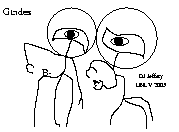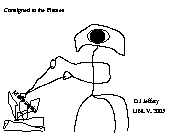-
Jump in with at any time, of course.
- Course Web Site: The
course web site URL is
http://physics.nhn.ou.edu/~jeffery/course/c_modern/modern.html
which is the page you are maybe viewing right now. This page is the preliminary syllabus and includes syllabus items and tentative schedule.
This page is/will be/may be linked from the official physics department course web page.
- Place and Time:
- Section 1: Janssen
Engineering Building (JEB) 328, MWF 8:30--9:20
Class schedule: physics and astronomy, 2008spring.
- Section 1: Janssen
Engineering Building (JEB) 328, MWF 8:30--9:20
Class schedule: physics and astronomy, 2008spring.
- Tutoring Help Available: This is in EP 309 according to
the TA Office Hours.
But this may be of little use to the folks in this class.
- Pre/Corequisites: As specified in the online
physics course descriptions.
- Phys 212,213: Engineering Physics II and III. Prerequisite. See physics course descriptions.
- Math 275: Analytic Geometry and Calculus III: Corequisite.
See the online
math course description, but it's essentially vector calculus.
- Breaks: No breaks for 50-minute lectures.
- Textbooks:
-
Eisberg, R., & Resnick, R., 1985, Quantum Physics, 2nd edition (ER)
$133.95, 864 pages.
See also modern physics books (ER).
-
A very good book in many respects I believe.
It covers almost all the topics of standard
modern physics
with some depth.
But not hard depth since it is very descriptive---some topics just
need some verbosity to be understood.
Most conventional modern physics books tend to be a bit superficial.
We are going to read the whole book---864 pages---but I won't lecture on all that---much will simply be assigned readings.
ER does have some problems. First of all it's a bit dated since it is unrevised since 1985. Modern physics hasn't changed, but the context of modern physics sure has. There will be no references to what is happening right now---e.g., Bose-Einstein condensates, nanotechnology, string theory, etc.
Second, it is undoubtably long---but that's really a virtue once you get into it.
Third, its interpretation of quantum mechanics (which doesn't affect any results) is not the one I hold. I believe that my view is more in line with the majority of contemporary quantum physicists---of which I am not one.
-
Greene, Brian, 2004, The Fabric of the Cosmos (Greene) $16.95, 592 pages.
See also modern physics books (Greene).
-
I believe (a long with many others) that this is an excellent
popular account of fundamental issues in contemporary physics
(which is the physics of right now).
I believe it is good to complement the standard modern physics topics with some contemporary physics at the light and fluffy level.
It has some demerits too.
Unrevised since 2004, it is already beginning to date---who remembers The Simpsons anyway---they're so 15 seconds ago.
Also Brian Greene (1963--) is a string theorist and a string theory proponent and his book goes into all that.
But string theory may turn out to be the wrong path---the Tao which is not the Tao---in which case a lot (but not all) of Greene's (i.e., the book's) interest may go proof--er poof---one day---but at present string theory is top dog on the frontier of physics.
See string theory (Wikipedia, 2007dec09) of an overview of the theory and controversy.
- Modern Physics Textbooks: These are other modern
physics textbooks that can be consulted.
-
Eisberg, R., & Resnick, R., 1985, Quantum Physics, 2nd edition (ER)
$133.95, 864 pages.
See also modern physics books (ER).
- Nature of the Course: This is a course of
modern physics.
But the adjective modern in the context of physics courses does NOT mean recently discovered physics.
Modern physics is modern in the sense that Picasso is a the modern painter and Hemingway is a modern writer.
Modern physics is the physics of roughly the first half of the 20th century--or from the fiducial discovery of X-rays in 1895 to the discovery of the Moessbauer effect in 1957.
-
There's no law against including more recent physics if it can be
wormed in somehow.
Much of the physics of modern physics is still considered correct subject to inevitable qualifications: e.g., in interpreting quantum mechanics.
Quantum mechanics is, in fact, is almost synonymous with modern physics, but a little special relativity is thrown in too.
However, this is not in a sense a course in quantum mechanics.
We tend to skirt the heavy math and formalism, and emphasize the applications in atomic physics, molecular physics, condensed matter physics (solid-state physics), and nuclear physics at the ground-floor entry level.
We will do a little depth, but the course is mainly aimed at breadth---getting to know the buzzwords and a bit more.
Heavy mathematical grinding in the formalism of quantum mechanics and detailed studies of specialized topics are for later courses.
Much of the course will be learning the physics qualitatively.
A few in-depth mathematical questions will occur along the way---and they will figure prominently on exams.
Some advanced topics that are modern physics in the Picasso sense are EXCLUDED as just too advanced: e.g., quantum electrodynamics (QED), quantum field theory, general relativity, and a whole lot more really.
There are standard items of courses in modern physics which are there for historical and heuristic reasons.
For example, the Bohr atom is a wrong theory.
It gives some right answers, but mostly wrong ones and it doesn't generalize beyond the one-electron atom case.
But the Bohr atom is easy to understand and was an important step on the road to quantum mechanics.
It's sort of an accident of nature that it exists---but it's not an accident that Niels Bohr (1885--1962) found it: he had the right ingredients and it was there to be found.
In general, modern physics is more abstract than classical physics---but classical physics really pretty abstract too, we are just more used to its abstractions.
One just has to get used to dealing with entities for which mental pictures, though very useful, will always be a bit inadequate and trust---but not completely trust---abstract laws, principles, and formulae.
It's no surprise to you that this is a pretty hard course.
It's hardness will be in the breadth and amount of reading (with comprehension) that you will have to do.
But has I always say, it's nothing like organic chemistry.
It all helps understanding eternity and infinity.
 Eternity and infinity from our small platform.
Eternity and infinity from our small platform.
As well as understanding home.
 Earthrise from Apollo 11, 1969jul16.
Credit:
NASA.
Earthrise from Apollo 11, 1969jul16.
Credit:
NASA.
- Readings: The readings are vital in the course.
There are 3 kinds of readings: ER chapters (18), ER appendices (18 not counting Appendix S), and Greene chapters (16 counting the chapter notes as part of the chapter and the preface as part of chapter 1).
-
The mathematically-inclined reader that
Greene keeps addressing in the
notes is you.
Each of the kinds is worth 5 % of the total grade for a total of 15 % of the total grade.
Students report to the instructor (preferably by email) when you have completed a reading and 1 point will be assigned for each reading: there 18, 18, and 16 points, respectively, for the ER chapters, ER appendices, and Greene chapters.
In the Tentative Schedule below, a schedule is given for the readings.
It is strongly urged that the students keep up to this schedule.
-
Cold feet are setting in already before day 1.
If the going gets way tough,
we may cut out some chapters or chapter sections.
I'll indicate such cuts on the
Tentative Schedule below.
But on the other hand, you'd really like to have had brush with all this stuff in the years to come.
Try to grind out 10 pages a day.
Maybe not even half.
The style of the lecturing will be to skip stuff readings cover and is easy to understand and needs no instructor explication---this means readings have to be done and as much in advance as possible.
-
The instructor will also skip when he's clueless---well
you know what they say: when the going gets tough, it's time to
bug out.
You should also be warned that instructors and books can both propagate misconceptions---a part of everyone's scientific life is clearing up misconceptions they acquired long ago from some formerly ``revered'' authority.
Some ER chapters, most ER appendices, and all of Greene are NOT going to be lectured on.
Naturally, what is not lectured on is going to less weighted in exams---I do try play fair.
- Homeworks: There will be 15 homeworks as specified in the Tentative Schedule below.
There is one for each of the fiducial lectures of the course.
The homeworks are NOT handed in.
But they are counted: 1 point for each: so 15 points in total.
The students report when they have completed homeworks (preferably by email) and their points will be assigned.
After the homework is completed, students are free to look at the posted solutions.
Homeworks count for 5 % of the total grade.
It is strongly urged that students keep up to the schedule on the homeworks.
Typically about 50 to 70 % or more of the exam questions will be drawn from the homeworks or, in the case of the FINAL, past exams also.
Questions that reappear on the exams might be tweeked a bit from previous versions.
New questions on exams will be similar to the homework questions.
Some will be challenging.
- Exams: There will be 2 in-class exams and a 2-hour COMPREHENSIVE FINAL.
The in-class exams cover the material up to some cut-off point that will be announced in class and on the course web in the Tentative Schedule .
The in-class tests are each worth 20 % of the total grade for a total of 40 % of the total grade.
The final is worth 40 % of the total grade.
The tentative dates for the exams are:
_________________________________________________________________ Exam Date Solutions (posted post-exam) _________________________________________________________________ Exam 1 Feb25 M Exam 1 solutions Exam 2 Apr25 F Exam 2 solutions Final Exam May07 W Final Exam solutions The final is at 7:30--9:30 am---not my call---in the regular class room as specified by Final exam schedule for 2008 Spring. _________________________________________________________________The in-class exams will consist of multiple-choice questions and a few full-answer questions that will be mostly mathematical.
The final will be like a double-class exam in terms of questions of various kinds.
The exams are closed-book.
-
An equation sheet will be provided: it's
the same equation sheet that comes with the homeworks.
Cell phones MUST be turned off and be out of sight.
There are NO scheduled review days, but the instructor may review some mathematical problems on request: remember the solutions to homework problems will be posted.
Make-up exams are possible, but students must ask for them promptly and avoid knowing anything about given exams.
- Evaluation and Grading: The 6 grading categories, their weightings, and their drops are:
ER chapter readings 5 % no drops ER appendix readings 5 % no drops Greene readings 5 % no drops homeworks 5 % 1 drop 2 in-class exams 40 % no drop 1 comprehensive final 40 % no dropEach in-class exam is worth 20 % of the final grade.Attendance is NOT kept and NO marks are assigned for attendance.
Students are encouraged to keep good attendance.
There are absolutely NO extra credits.
Letter grades will be assigned following the UI catalog---which allow instructors some freedom of interpretation.
The instructor uses a curve to automatically assign letter grades during the semester. There is no fixed scale.
The final grades are decided on by the instructor directly.
Students can always ask the instructor for their current mark record and letter grades. Queries by email are probably best for this.
The instructor will submit midterm grades and final grades as scheduled in the academic calendar.
Remember that after an instructor has submitted final grades, any adjustment (except for purely clerical error) is extremely difficult. Students should make any queries about their final grades before the instructor submits them.
 Beware of aliens bearing grades.
Beware of aliens bearing grades.
- Readings: The readings are vital in the course.
No dated schedule has ever been adhered to by the instructor.
So there are no dates in this tentative schedule.
However, we have 16 weeks in the semester (not counting spring break) and we will lose about a week of classes for in-class exams, the missing first Monday, and holidays (i.e., Martin Luther King Day and Presidents Day).
So about 15 weeks and 45 lecture class hours.
So I've divided the course into 15 fiducial lectures.
Each lecture will be covered in about a week.
I'm going to try to provide photocopied and/or posted lecture notes.
It's inefficient I think to make the rate-determining steps of a class the speed at which I can write things on the board and the speed at which students can transcribe these faux pearls.
-
Unfortunately, I've written them in
Irish Gaelic, but tis no problem: it's an
Indo-European language
just like English
and Sanskrit and you'll
soon get the hang of it.
If more time is needed to complete a lecture, it won't be completed---the material is all assigned reading anyway---unless I really, really want to complete the lecture.
Remember the Pirate Code:
- Special Relativity (SR)
This is the traditional initial topic of
modern physics.
ER-A-1:
The Special Theory of Relativity.
-
Readings ER-A, Greene-(preface,1)
Lecture 1 notes
Homework 1: Due:
Solutions 1:
- Blackbody Radiation ER-1: Thermal Radiation and Planck's Postulate
-
Readings ER-1, ER-B,C, Greene-2
Homework 2: Due:
Solutions 2:
- Photons ER-2 Photons---Particlelike Properties of Radiation
-
Readings ER-2, Greene-3
Homework 3: Due:
Solutions 3:
Exam 1 solutions: February 25, Monday- Matter Waves E-3: De Broglie's Postulate---Wavelike Properties of Matter and E-4: Bohr's Model of the Atom
-
Readings ER-3,4(no lecture), ER-D,E, Greene-4
Homework 4: Due:
Solutions 4:
- Non-Relativistic Quantum Mechanics ER-5: Schroedinger's Theory of Quantum Mechanics
-
Readings ER-5, ER-F,G, Greene-5
Homework 5: Due:
Solutions 5:
- Applications of One-Dimensional NR Quantum Mechanics ER-6: Solutions of Time-Independent Schroedinger Equations
-
Readings ER-6, ER-H,I, Greene-5
Homework 6: Due:
Solutions 6:
- Hydrogenic Atom ER-7: One-Electron Atoms
-
Readings ER-7, ER-M,N, Greene-6
Homework 7: Due:
Solutions 7:
Exam 2 Solutions:
- Spin, Magnetic Dipole Moments, Spin-Orbit Interaction: ER: Magnetic Dipole Moments, Spin, and Transition Rates
-
Readings ER-8, ER-O, Greene-7
Homework 8: Due:
Solutions 8:
- Lecture 8: Multielectron Atoms---Ground States and X-Ray Excitations
-
Readings ER-9, Greene-8
Homework 8: Due:
Solutions 8:
- Lecture 9: Multielectron Atoms---Optical Excitations
-
Readings ER-10, ER-J,K,P, Greene-9
Homework 9: Due:
Solutions 9:
- Lecture 10: Quantum Statistics and Molecules
-
Readings ER-11,12(no lecture), Greene-10
Homework 10: Due:
Solutions 10:
- Lecture 11: Solids---Conductors and Semiconductors
-
Readings ER-13,14(no lecture), ER-Q, Greene-11
Homework 11: Due:
Solutions 11:
- Lecture 12: Nuclear Models
-
Readings ER-15, Greene-12
Homework 12: Due:
Solutions 12:
- Lecture 13: Nuclear Decay and Nuclear Reactions
-
Readings ER-16, Greene-13
Homework 13: Due:
Solutions 13:
- Lecture 14: Introduction to Elementary Particles
-
Readings ER-17, Greene-14
Homework 14: Due:
Solutions 14:
Exam 2 solutions: Taken Apr25, Friday.- Lecture 15: More Elementary Particles
-
Readings ER-18, Greene-15,16
Homework 15: Due:
Solutions 15:
Final exam solutions: Taken May07, Wednesday. - Blackbody Radiation ER-1: Thermal Radiation and Planck's Postulate

